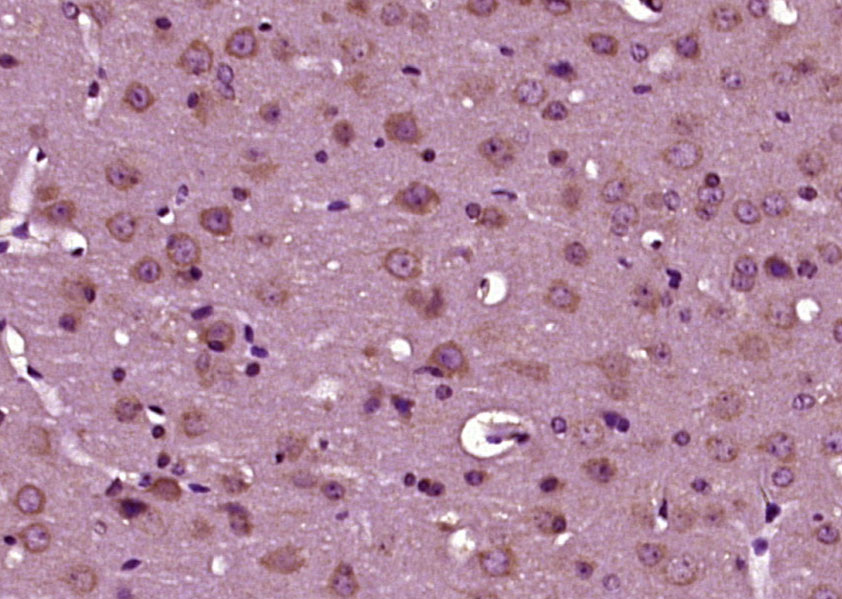
Rabbit Anti-phospho-CTNNA1 (Ser641)antibody
p-CTNNA1 (Ser641); CTNNA1 (phospho-Ser641); CTNNA1 (phospho-S641); alpha 1 Catenin (phospho S641); alpha catenin; alpha E catenin; alphaE catenin; Cadherin associated protein 102kDa; Cadherin associated protein; CAP 102; CAP102; Catenin (cadherin associat
View History [Clear]
Details
Product Name phospho-CTNNA1 (Ser641) Chinese Name 磷酸化α-连环蛋白抗体 Alias p-CTNNA1 (Ser641); CTNNA1 (phospho-Ser641); CTNNA1 (phospho-S641); alpha 1 Catenin (phospho S641); alpha catenin; alpha E catenin; alphaE catenin; Cadherin associated protein 102kDa; Cadherin associated protein; CAP 102; CAP102; Catenin (cadherin associated protein) alpha 1 102kDa; Catenin alpha 1; CTNNA 1; CTNNA1; Alpha-cats; FLJ36832; NY REN 13 antigen; CTNA1_HUMAN. Catenin α; Catenin-α; Catenin-α1; Catenin α1; α Catenin; 钙粘蛋白相关蛋白; Product Type Phosphorylated anti Research Area Tumour Cell biology immunology Signal transduction Stem cells Cell adhesion molecule Cytoskeleton Immunogen Species Rabbit Clonality Polyclonal React Species Human, Mouse, (predicted: Rat, Chicken, Dog, Pig, Cow, Horse, Rabbit, Sheep, ) Applications IHC-P=1:100-500 IHC-F=1:100-500 IF=1:100-500 (Paraffin sections need antigen repair)
not yet tested in other applications.
optimal dilutions/concentrations should be determined by the end user.Theoretical molecular weight 100kDa Cellular localization cytoplasmic The cell membrane Form Liquid Concentration 1mg/ml immunogen KLH conjugated Synthesised phosphopeptide derived from human CTNNA1 around the phosphorylation site of Ser641: DD(p-S)DF Lsotype IgG Purification affinity purified by Protein A Buffer Solution 0.01M TBS(pH7.4) with 1% BSA, 0.03% Proclin300 and 50% Glycerol. Storage Shipped at 4℃. Store at -20 °C for one year. Avoid repeated freeze/thaw cycles. Attention This product as supplied is intended for research use only, not for use in human, therapeutic or diagnostic applications. PubMed PubMed Product Detail The distinct peripheral cytosolic proteins, alpha, beta and gamma-catenin (102, 94 and 86 kDa) found in many tissues bind to the conserved cytoplasmic tail domain of the cell-adhesion cadherins. Catenins link E-cadherin to other integral membrane or cytoplasmic proteins and are modulated by Wnt-1 proto-oncogene. They are good candidates for mediating transduction of cell-cell contact positional signals to the cell interior. Absence of alpha-catenin is found in certain tumor cell lines and reduced levels in certain human carcinomas. Beta-catenin binds directly to the cytoplasmic tail of E-cadherin. It binds to the N-terminus of alpha-catenin and interacts with the protein product of the tumor suppressor gene APC. This interaction involves a 15-aa repeat in the APC. Beta-catenin cell levels seem to be controlled by APC. The central core region of beta-catenin is involved in mediation of cadherin-catenin complex interaction with EGFR.
Function:
Associates with the cytoplasmic domain of a variety of cadherins. The association of catenins to cadherins produces a complex which is linked to the actin filament network, and which seems to be of primary importance for cadherins cell-adhesion properties. Can associate with both E- and N-cadherins. Originally believed to be a stable component of E-cadherin/catenin adhesion complexes and to mediate the linkage of cadherins to the actin cytoskeleton at adherens junctions. In contrast, cortical actin was found to be much more dynamic than E-cadherin/catenin complexes and CTNNA1 was shown not to bind to F-actin when assembled in the complex suggesting a different linkage between actin and adherens junctions components. The homodimeric form may regulate actin filament assembly and inhibit actin branching by competing with the Arp2/3 complex for binding to actin filaments. May play a crucial role in cell differentiation.
Subunit:
Monomer and homodimer; the monomer preferentially binds to CTNNB1 and the homodimer to actin. Binds MLLT4 and F-actin. Possible component of an E-cadherin/ catenin adhesion complex together with E-cadherin/CDH1 and beta-catenin/CTNNB1 or gamma-catenin/JUP; the complex is located to adherens junctions. The stable association of CTNNA1 is controversial as CTNNA1 was shown not to bind to F-actin when assembled in the complex. Alternatively, the CTNNA1-containing complex may be linked to F-actin by other proteins such as LIMA1. Interacts with ARHGAP21 and with AJUBA. Interacts with LIMA1.
Subcellular Location:
Cytoplasm, cytoskeleton. Cell junction, adherens junction. Cell membrane; Peripheral membrane protein; Cytoplasmic side. Cell junction. Note=Found at cell-cell boundaries and probably at cell-matrix boundaries.
Tissue Specificity:
Expressed ubiquitously in normal tissues.
Post-translational modifications:
Sumoylated.
Similarity:
Belongs to the vinculin/alpha-catenin family.
SWISS:
P35221
Gene ID:
1495
Database links:Entrez Gene: 1495 Human
Entrez Gene: 12385 Mouse
Omim: 116805 Human
SwissProt: P35221 Human
SwissProt: P26231 Mouse
α-catenin是一种多功能的蛋白质,能链接E-\N-\P-钙粘附分子,具有参与细胞粘附和介导Signal transduction的双重功能,并与Tumour的发生发展及浸润密切相关。 在正常个体中,βα-catenin和钙黏蛋白形成复合体,介导同型细胞的粘附,维持细胞的稳定;同时,α-catenin作为Wnt/α-catenin信号通路的关键成员在介导Signal transduction过程中调控细胞的增殖和凋亡。 在恶性Tumour中,α-catenin的表达呈现明显的异质性,促使细胞异常增殖,还可使细胞之间的黏附性减弱,侵袭性增强。Product Picture
Bought notes(bought amounts latest0)
No one bought this product
User Comment(Total0User Comment Num)
- No comment



 +86 571 56623320
+86 571 56623320
 +86 18668110335
+86 18668110335

